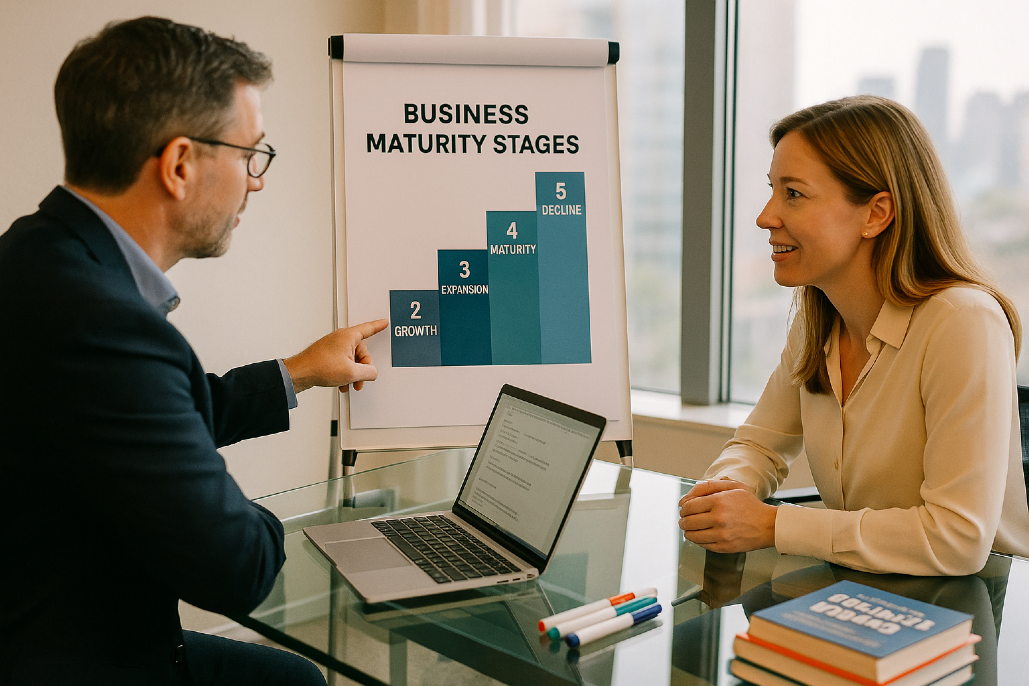Unlocking Growth: The Business Maturity Model For Solo Consultants
This started with some client feedback. Whilst they were delighted with the client-led approach I offered, they wanted more structure and processes to help them with the sheer volume of things they had to address as a solo consultant ... The Business Maturity Model, Growth and success flow, From strong foundations built well, Maturity blooms And of course they stated that time-honoured cry of “I don't know what I don't know”, and they are right. When it comes to setting up a business, there is plenty to get to know. So, rising to the challenge, I started researching the different ways I could address this, and along came TheAx.ai. Who are tackling the same need as I am, but they focus more on working with larger companies, and their models reflect that. So we added a Maturity Model for Solo Consultants to their offering, and I became an affiliate partner. As solo consultants, we often find ourselves so immersed in serving our clients that our own business growth can take a back seat.But what if there was a structured way to assess, understand, and strategically improve your consulting practice, just as you help your clients improve theirs? This is where a Business Maturity Model comes in - a powerful framework you can apply both to your own business and introduce to your clients. What is a Business Maturity Model?A Business Maturity Model provides you with a structured pathway to evaluate the sophistication and effectiveness of your organisation's processes, capabilities, and strategic approach. It typically outlines several stages of maturity, from learning what a consultant needs to run a business consultancy through intermediary steps, to offer you clear indicators of progress and areas for development. For solo consultants, this model isn't about rigid corporate structures, but rather about identifying key areas of your practice - from client acquisition to service delivery to operational efficiency - and understanding how mature your approach is in each. Applying the Model to Your Solo Consultancy Based on my own engagements and insights from our partner organisation TheAx.ai, we've adapted a simplified Business Maturity Model perfectly suited for solo consultants. Here's how you can assess your own business. Where are you now, and where would you like to be?
Categories of functions to run an effective consultancy. Above, I've given you an overview of the stages you will need to go through to become known as and feel like you are operating as the expert in your field. So far, I've answered my clients' feedback, which was for more structure in helping them, but I imagine many of you are thinking, "the devil is in the details". Never fear, there is plenty of that, and it comes next. We have identified eleven categories of knowledge, skills, and behaviours that you will need to master to take your consultancy to the next level. 1. Identity & Mindset Represents the internal shift from employee to entrepreneur. It includes developing self-confidence, embracing autonomy, and taking full ownership of both wins and losses. The consultant must grow comfortable with uncertainty, risk, and self-direction. This involves cultivating resilience, discipline, and a reflective mindset that sees every experience as a learning opportunity. It also includes setting boundaries, managing energy, and staying connected to a clear purpose or “why.” As consultants mature, their mindset evolves from reactive and uncertain to strategic and empowered. See, hear, do and feel. Building stamina, resilience, and appropriate levels of stress. Impact on family/significant others. 2. Value Proposition & Offer A consultant's value proposition is the foundation of their business - what they do, who they do it for, and why it matters. Early on, this may be vague or overly broad. As they develop, consultants learn to define a tight niche and communicate their value clearly and confidently. This includes identifying client pain points, differentiating themselves from competitors, and shaping services into clear offers that solve real problems. With maturity, offers are no longer just based on effort or time, but on outcomes - often productised and priced around client results 3. Client Acquisition & Relationship Management This is the ability to attract, convert, and retain ideal clients. It covers everything from building a personal brand and crafting an elevator pitch to lead generation, content marketing, proposals, and pricing strategy. Many new consultants struggle here, but with experience, they build consistent marketing habits, test what works, and refine their outreach. They move from random posts or cold pitches to strategic campaigns and thought leadership. Mature consultants have predictable pipelines and often benefit from inbound leads through reputation and visibility. 4. Networking & Relationships Relationships are the lifeblood of a consultancy. This dimension includes nurturing your professional network, building trust, and staying top-of-mind with potential collaborators, referral partners, and clients. Early-stage consultants may rely on a few old contacts, while more advanced ones build diverse, strategic networks that support business growth. This includes joining professional groups, showing up consistently online and offline, and giving value without immediate expectations. Mature consultants become known connectors and gain introductions with ease. 5. Delivery & Consulting Skills Beyond subject matter expertise, this dimension covers the consultant's ability to diagnose problems, engage stakeholders, communicate clearly, and deliver results. It includes facilitation, project management, coaching, storytelling, and presentation skills. At early levels, consultants often “do the work” like an employee; later, they learn to guide, influence, and co-create with clients. They learn to frame insights, manage scope, and measure impact. High-level consultants deliver strategic transformation, not just tasks. 6. Operations & Infrastructure A well-run consultancy depends on behind-the-scenes systems and tools. This includes legal setup (sole trader vs. Ltd), contracts, invoicing, accounting software, scheduling tools, and templates for proposals and delivery. Early-stage consultants may rely on manual processes and improvised systems. As they mature, they standardise, automate, and streamline. Infrastructure also includes insurance, data security, and GDPR compliance. Mature consultants operate efficiently and professionally, freeing up time for high-value work. 7. Intellectual Property & Productisation This dimension reflects the development of repeatable frameworks, methods, or tools that codify your expertise. It begins with documenting learnings and creating templates, and grows into formalised models, toolkits, or diagnostics. These assets reduce delivery time, increase quality, and enhance perceived value. Productisation turns services into scalable, repeatable offers - like workshops, audits, or strategy sprints. At the highest levels, consultants license or brand their IP, turning knowledge into leverage. Key differentiator. 8. Client Reputation & Results Reputation is built through outcomes. This dimension tracks how effectively a consultant builds trust, delivers value, and earns repeat business or referrals. It begins with collecting testimonials and ends with being a “go-to” name in their niche. Consultants grow by using client feedback to improve, building case studies, and demonstrating measurable impact. They shift from short-term gigs to long-term partnerships. At higher levels, clients seek them out based on reputation alone. 9. AI Enablement & Tooling AI is a force multiplier for consultants. This dimension includes the adoption and integration of AI tools for research, diagnostics, content creation, proposal generation, or client insights. At early levels, consultants may use basic writing or design tools. As they mature, they integrate platforms like TheAX to power audits, automate pre-sales, and productise delivery. Advanced consultants design services that use AI not just for efficiency, but to deepen insights and scale delivery with minimal effort. 10. Financial Planning & Discipline Financial clarity is essential for a sustainable business. This dimension includes budgeting, setting prices, forecasting income, tax planning, and cash flow management. At the start, consultants often undercharge, mix personal and business finances, or forget to plan for tax. With maturity, they implement software, track metrics, manage reserves, and set boundaries around payment terms. Pricing moves from hourly or day rates to project fees and value-based models. Mature consultants understand their numbers and use them to make confident decisions. 11. Barriers to success This category acknowledges the inner and outer challenges that prevent progress - such as mindset blocks, lack of clarity, operational chaos, or market misalignment. So how do you introduce the model to your clients? This model isn't just for you; it's an invaluable tool to introduce to your clients. It provides a common language and a clear framework for them to understand their own organisational challenges and the journey they need to undertake to achieve their goals. How to introduce it:
The benefits include:
By embracing the Business Maturity Model for your solo consultancy, you're not just growing your own business; you're also equipping yourself with a robust framework to guide your clients toward their own success. It's about building a more strategic, resilient, and thriving consulting practice - for yourself and those you serve. Until next time ... JACKY SHERMAN
| ||||||||||||||||||||||||||||||||||||||||||||||||||||||||||||||||||||||||||||||




 | Jacky Sherman The Consultant's Consultant ... |













